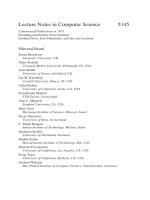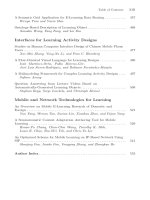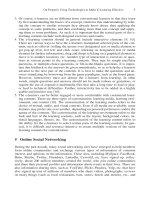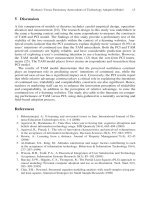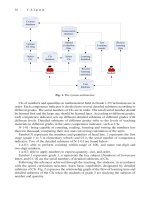Lecture Notes in Computer Science- P109 ppt
Bạn đang xem bản rút gọn của tài liệu. Xem và tải ngay bản đầy đủ của tài liệu tại đây (152.12 KB, 5 trang )
F. Li et al. (Eds.): ICWL 2008, LNCS 5145, pp. 529–540, 2008.
© Springer-Verlag Berlin Heidelberg 2008
A Semiautomatic Content Adaptation Authoring Tool
for Mobile Learning
Hsuan-Pu Chang
1
, Chun-Chia Wang
2
, Timothy K. Shih
1
, Louis R. Chao
1
,
Shu-Wei Yeh
1
, and Chen-Yu Lee
3
1
Department of Computer Science and Information Engineering, Tamkang University,
Taiwan
2
Department of Information Management, Technology and Science Institute of Northern
Taiwan, Taiwan
3
Digital Education Institute, Institute for Information Industry, Taiwan
Abstract. A lot of studies about automatic content adaptation have been done
and are proposed to overcome the drawbacks of browsing regular content with
handheld devices such as pocket PCs and smartphones. But we argue that the
total automatic adaptation algorithm designed by an engineer to transform Web
Page presentation is still appropriate to be applied on educational content.
Therefore, this paper proposes a learning content adaptation tool that provides
different adaptation templates to help the author automatically and efficiently
reproduce high-quality learning content for specific handhelds. Furthermore,
the author will not only be able to preview the adaptation result before publish-
ing the course but also be able to adjust the template parameters manually to af-
fect the process if they are not satisfied with the current result. Finally the new
adapted content can be packaged with original content as a multi-version learn-
ing course.
1 Introduction
The need to adapt content for use on handhelds has been long recognized 34, and both
manual and automatic approaches to implement the content adaptation have been pro-
posed. This research 5[6]79 mostly focused on adapting normal Web Pages such as
commercial web sites or portal sites. There have been a lot of automatic approaches
designed to provide a real time content adaptation system for browsing Web Pages on
handhelds. On the other hand, manual adaptation techniques, such as WAP89, have high
cost for data producers who are required to maintain multiple versions of the content.
We believe that automatic and manual mechanisms are equally important for adapt-
ing learning content. Adopting the total automatic approach for adapting content with-
out supervision by educators or authors may lead to the adapted result becomes unpre-
dictable and unexpected even results possibly lose its educational essence. Contrarily,
requiring a teacher to manually reproduce and maintain courses for a variety of mobile
learning platforms is not intelligent. Because it does exist, an optimal adaptation ap-
proach that can perfectly satisfy various adaptation requirements, as well as existing
learning material should never be adapted due to their educational characteristics or
530 H P. Chang et al.
author’s will. So, the main purposes of our project
1
are specifically listed as follows, (1)
we propose a web-based content adaptation tool that uses templates to automatically and
efficiently adapt content for mobile learning; (2) through adjusting the template’s pa-
rameters, users can easily manipulate the process and change the result if they are dis-
satisfied; (3) the tool allows user to preview the adapted content and decide whether it is
appropriate to read on handhelds.
2 Related Works
The proposed authoring tool allows authors to produce the adapted content for the
sake of appropriately displaying it on specific mobile learning platforms. After finish-
ing the editing phase, the author has alternative way to package the new adapted con-
tent: creating another totally independent course package or packaging the adapted
content associated with the original content package. Despite what kinds of packaging
way to handle the adapted content, the package formats are following the international
e-learning standard: ADL SCORM 1 and IMS Common Cartridge 2.
2.1 IMS Common Cartridge Package File Structure
The diagram in figure 1 shows the overall layout of the common cartridge package
interchange file structure.
z imsmanifest.xml
The standard IMS manifest file that is a mandatory XML file describing the
package itself. In the absence of this file, the package is not an IMS package
Fig. 1. Common Cartridge package interchange file
1
This paper is supported by the Digital education Institute, Institute for Information Industry,
Taiwan , R.O.C., under grant number #96-EC-17-A-02-R7-0808.
A Semiautomatic Content Adaptation Authoring Tool for Mobile Learning 531
and cannot be processed. It is required the name be kept, as above, in all
lowercase letters.
z Learning Application Object Resources
These are resources that describe the attributes of a particular Learning Ap-
plication Object. Examples include SCORM packages, QTI files and discus-
sions top descriptors. The information will generally be parsed on input and
transformed into internal data structures in the Learning Management System
(LMS).
z Web Content Resources
These represent standard web content types such as HTML files, images,
movies etc. Two main scopes for web content resources are supported: Car-
tridge scoped web content and Learning Application Object scoped web con-
tent. These web content resources can be organized into directories in the
package interchange file and the directories will be included in the importing
LMS to ensure relative links between web content continue to work.
z Using Directory in Package Interchange File
File system directory can be used to organize content within the package in-
terchange file. It is required that the resources specific to a given Learning
Application Object are packaged in a distinct directory in the package inter-
change file.
2.2 Related Literatures
Adaptation is a well-studied topic in mobile and pervasive computing for years
[10][11]. Hwang et al. proposed a transcoding framework [12] that represents a Web
page as a modified tree structure to efficiently analyze and transcode pages. It is based
on html syntax analysis and structure-aware techniques that intend to make complex
Web pages accessible and reflect the relative importance of Web components during
the transcoding process.
The design guidelines for such PDA devices are also introduced and discussed
in [13]. These guidelines can be classified according to which aspect of the Web me-
dia they are related: software/hardware, content and its organization, or aesthetic and
layout.
On the other hand, refer to textual web content summarization [14], the methods
for summarizing are introduced to handle the textual Web pages and HTML forms. A
Web page is separated into text units that can each be hidden or partially displayed.
Six different display modes are introduced that utilizes the progressive displaying
textual units with keyword extraction and paragraph summarization to gain an over-
view of a page. They found that the combination of keywords and summaries pro-
vides the most significant improvements in access time and number of required pen
actions.
Usage-AwaRe Interactive Content Adaptation (UARICA) and Feedback-driven
Context Selection (FCS) [15] made adaptation prediction for a user based on the his-
tory of the community of users and reflect both the user’s context and content’s usage
semantics. Iqbal et al. think optimal adaptation is a challenging problem because
it often depends on the usage semantic of content, as well as the context of users
532 H P. Chang et al.
(e.g., screen size of device being used, network connectivity, location, etc.) Their
works included an automatic techniques, UARICA that allows a user who is unsatis-
fied with the adaptation prediction to take control of the adaptation process and make
changes until the content is suitably adapted for his/her purpose. Moreover, FCS takes
advantages of user interaction to determine those contextual characteristics that have
the most impact on the adaptation requirements of an object, and therefore should be
the basis of grouping users into communities.
3 Proposed Learning Content Adaptation Models
Our proposed adaptation framework is composed of three main adaptation models.
First, the textual adaptation model is responsible for handling the complicated textual
body that may make users feel confused or lost while reading on a restricted small
screen. Precisely speaking, our content adaptation tool will summarize textual body
and utilize progressive disclosure presentation to revel the original content. We refer-
enced Buyukkokten’s [14] progressive disclosure for text, it combined with keywords
and a summary help present the original content incrementally, has the best improve-
ment of average I/O expenditure and completion time across all tasks they had
experimented.
Second, the image adaptation model takes into account the requirement for adapt-
ing image size when displaying it on a handheld. Briefly speaking, an image will be
automatically shrunk if it is too big to display on a handheld, as well as expanded if it
is too small. Finally, the layout adaptation model is able to reorganize the layout of
adapted elements properly according to the display ability of different handheld de-
vices. But there are a few questions associated with previous descriptions. Exactly
which textual body is needed to be summarized? How do we evaluate and decide
whether a picture is required to be shrunk or expanded? Consequently, before we
continue to detail each adaptation module, the presentation unit (PU) and screen unit
(SU) will first need to be introduced.
3.1 Screen Unit (SU) and Presentation Unit (PU)
The adaptation process begins by partitioning the content into presentation unites
(PUs). A content page will be separated into several PUs, which instead of presenting
in the actual HTML, each PU is a rectangle around a section which typically presents
a paragraph, list, table, image, etc. Accordingly, each PU is considered as a basic unit
of the adaptation process. Because each PU contains various contents, the question is
which SU should execute the adaptation process. We will define the other unit,
namely screen unit (SU), that helps us to evaluate and decide which PU is required to
be adapted.
Figure 2 shows the display area size of a PU is varies because it may contain a
paragraph or an image. On the contrary, a SU is a virtual rectangle presentation block
where the boundary is fixed according to different handhelds displaying ability. Pre-
cisely speaking, the size of a SU is matched to correspond to the screen sizes of hand-
helds. For example, pocket PC’s and Smartphone’s in which the typical resolution are
240*320 and 176*220 respectively.
A Semiautomatic Content Adaptation Authoring Tool for Mobile Learning 533
Fig. 2. Dividing a html-based content page into several PUs
The content of each PU will be retrieved then filled into each SU. The main con-
cept is that it does not need to adapt a text or image within a PU if it can be entirely
displayed within a single SU without additional scrolling. Mathematically, we evalu-
ated whether a PU is required to be adapted with a simple formula that calculates a
threshold value. We defined a value, textual information density (TID) as follows:
TID = number of words in a PU / area of a SU (1)
The area of a SU is constant according to which adapted target platform is required
by a user. The default value of TID is allowing a PU to present the maximum number
of words without additional scrolling. Users are also allowed to adjust the TID, which
will affect which PU is required to be adapted. For example, a larger TID allows a
good deal of textual information located in a PU without any summarization so that
the user may need more necessary scrolling actions for reading.
3.2 Textual Adaptation Model
This need for frequent scrolling can seriously degrade the learning efficiency and
performance. Providing a simplified overview is another important adaptation guide-
line as well.
Therefore, for text summarization, we referenced Buyukkokten’s approach to ex-
tract keywords from web pages. Their content adaptation approach utilizes keywords
and summary sentences to partially represent the original text, then disclose informa-
tion progressively as figure 3.1 shows. The main difference is that our adaptation unit
is a PU and only when its TID is higher than the chosen threshold value will it trigger
the adaptation process. Next, the details of how to extract keywords and summary
sentences will be introduced.
3.2.1 Keyword Extraction
Keyword extraction from a text body relies on an evaluation of each word’s impor-
tance. The importance of a word W is dependent on how often it occurs within the
body of text, and how often the word occurs within a larger collection that the text is
part of. Intuitively, a word in given text will be considered as the most important one

